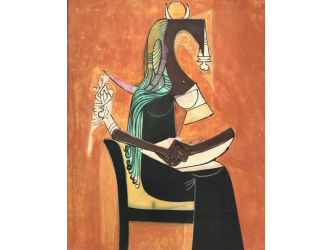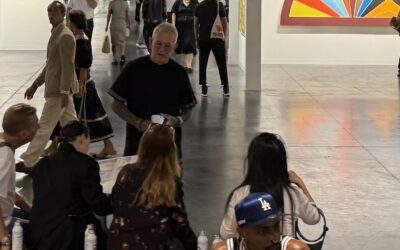Just a banana
It seemed like a throwaway work. A banana taped to a wall with silver duct tape, unveiled in 2019 at the Art Basel Miami Beach fair. A cheeky jab at the art system, its market and what counts as “good taste”. Immediately sold for $120,000, this work, imagined by the Italian artist Maurizio Cattelan (born in 1960), who lives between Milan and New York, became a massive phenomenon—a playful symbol of what the general public doesn’t understand about today’s art.
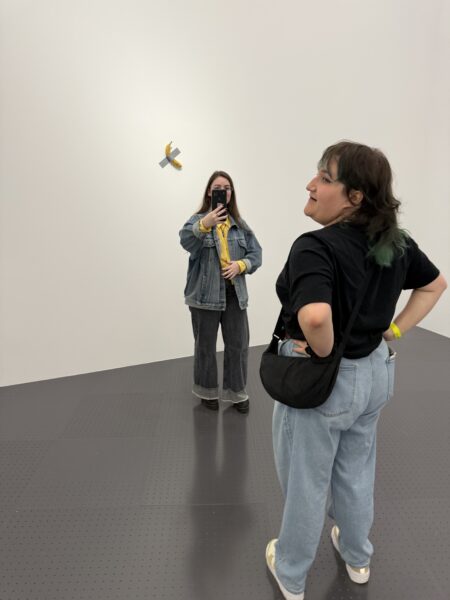
Centre Pompidou Metz
But ‘Comedian,’ as it is called, only exists through a certificate containing precise instructions. Contrary to appearances, it is a serious conceptual work, a direct heir to Marcel Duchamp’s ready-mades (1) (See here a report about the value of Comedian).
Maurizio speaks
“Catholics speak of before and after Christ. For me, it’s before and after ‘Comedian.’ The banana is the new century,” says the artist. (He generously granted me an exclusive interview, even though he rarely speaks on camera. Back in 2016, he had allowed me to discreetly film him climbing the rooftops of Paris.)
To disorient visitors
In Metz, at the Centre Pompidou, the banana is the ‘guest star’ of a major show co-curated by Cattelan and Chiara Parisi, the museum’s director (See here an interview of Chiara Parisi about Suzanne Valadon). The exhibition is the result of a successful union between 400 works selected from the 120,000 in the vast collection of the Musée National d’Art Moderne and 40 pieces by the mischievous Italian. The layout, both fluid and exuberant, was deliberately designed, according to the artist, “to disorient visitors in the labyrinth that follows Shigeru Ban’s architecture. We worked for a year and a half on the project. Working outside of Paris is a different experience. You can experiment. We want to push the limits.”
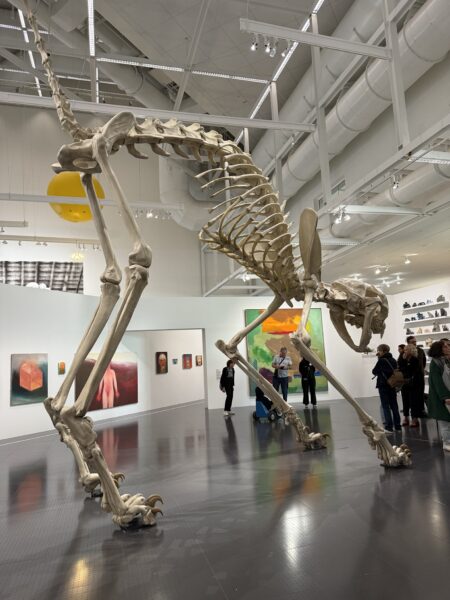
Maurizio Cattelan
André Breton and La Gradiva
Near the wall of André Breton—an installation made of 250 assorted objects and a true statement of Surrealist theory—a Roman bas-relief depicts “Gradiva,” a woman with a fascinating gait who was the subject of a novella by Wilhelm Jensen which was then analyzed by Freud in 1907. Art historians will also remember Gradiva as the name Breton gave to his art gallery located on Rue de Seine in Paris in 1937.
Joseph Beuys
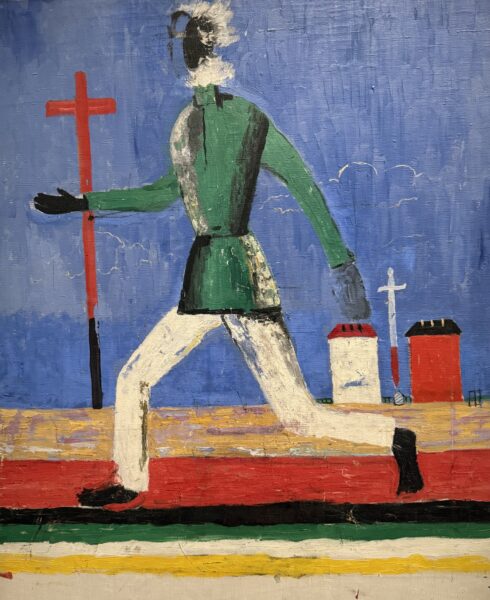
Kasimir Malevich
As dazzling as the lineup may be—from a 1930 painting by Malevich (“Sensation of Danger”) to a series of 17 raw and colorful canvases by Swiss artist Miriam Cahn (born in 1949)—Cattelan, a keen connoisseur of contemporary art history, laments the absence of one of his obsessions: a legendary installation by Joseph Beuys, “Plight,” entirely lined with felt, which is currently under restoration.
The big misunderstanding

Maurizio Cattelan
Maurizio has a deep interest in art history. The exhibition is structured like an alphabet book, with themes that are, admittedly, somewhat obscure. In the especially well-crafted exhibition catalogue, Cattelan reflects on a misunderstanding:
“People often take me for a jester, a clown, a comedian or a provocateur. I’ve come to accept the label—as long as it applies to my face, my media image, and not to my art.”
I needed a break

Michelangelo Pistoletto
In 2012, during his retrospective at the Guggenheim in New York, he had even announced he would no longer produce new work: “I needed a break. I thought it was for good. But I kept creating images for magazines, so why not return to what I was doing before…
Today, if I produce one piece a year that surprises me even a little, that adds a small punctuation mark to my vocabulary, I’m satisfied.”
Self-portrait is a paradox
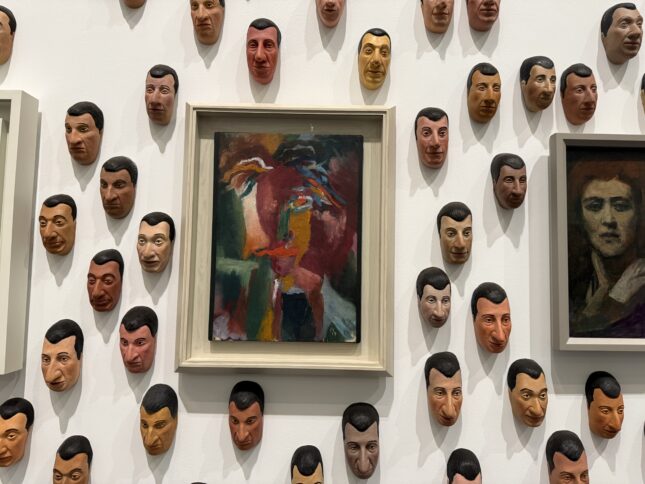
Maurizio Cattelan, Gino Severini
One of the most successful rooms in the show is dedicated to self-portraits: “A self-portrait is a paradox. It speaks of me, but also of we. You know, I spend a lot of time alone. I’m not as sociable as I may seem.”
Little Maurizios
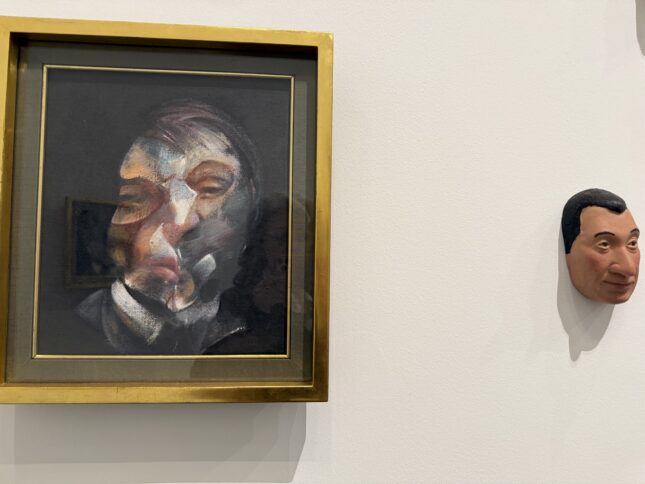
Francis Bacon, Maurizio Cattelan
Near two self-portraits by Francis Bacon is “Spermini,” a set of 92 tiny masks portraying Cattelan, like so many potential little Maurizios. Also roaming the space is Charlie, a child mannequin with Cattelan’s face, riding a remote-controlled tricycle that keeps visitors entertained.
Marcel Duchamp , spiritual father
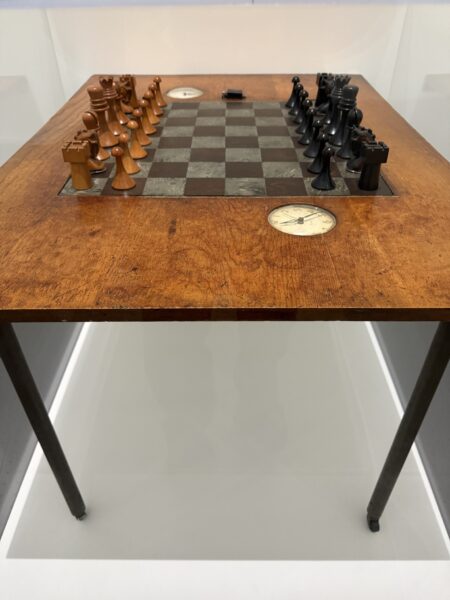
Marcel Duchamp
A highly symbolic room is also dedicated to chess, the passionate hobby of Marcel Duchamp—who could be seen as Cattelan’s spiritual father: “Duchamp opened the doors to modern and contemporary art. Now we’re waiting for someone to open the doors to the art of the future, without repeating what has already been done,” he says, thrilled at the idea of unveiling a new public piece in Bergamo this June.
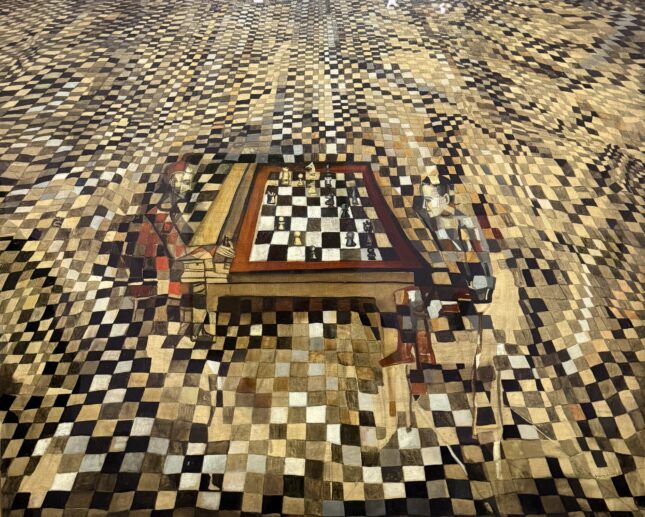
Maria Elena Vieira da Silva
Montesquieu, an other spiritual father
As Montesquieu wrote in his “Pensées”: “I have always seen that to succeed in the world, one must appear mad and be wise.” Cattelan—the secret scholar—must have taken it to heart.

Maurizio Cattelan, Franz West
Through February 2, 2027. www.centrepompidou-metz.fr/de
(1) On November 19, 2024, this much-coveted fruit was even sold for $6.2 million to Chinese cryptocurrency investor Justin Sun.
Support independent news on art.
Your contribution : Make a monthly commitment to support JB Reports or a one-off contribution as and when you feel like it. Choose the option that suits you best.
Need to cancel a recurring donation? Please go here.
The donation is considered to be a subscription for a fee set by the donor and for a duration also set by the donor.


